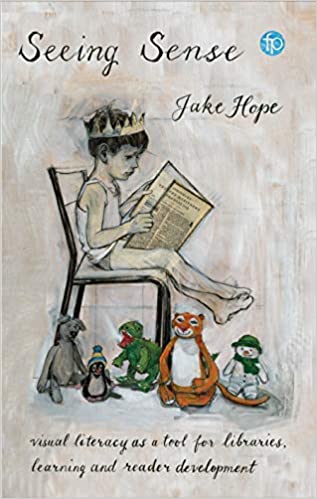
Price: £39.95
Publisher: Facet Publishing
Genre: Non Fiction
Age Range: Books About Children's Books
Length: 224pp
Buy the Book
Seeing Sense: visual literacy as a tool for libraries, learning and reader development
Jake Hope explores a variety of ways of thinking about visual literacy in the context of children’s books and libraries in this useful toolkit for librarians, published by CILIP. The reader will be left in no doubt about the power of the visual environment, and of picture books in particular, to enhance and enrich our lives. The book is divided into sections exploring visual literacy, reading, the importance of visual representation and inclusion, alongside a consideration of aspects of the publishing world, the role of illustration prizes and awards and the creation of visually rich learning environments. There are examples of good practice and case studies throughout. The strongest sections are the many interviews that Jake has carried out with practitioners in the field of children’s literature, particularly those concerned with illustration and book production. It is fascinating to hear an illustrator’s thought processes and the ideas behind the books, and also to hear from agents, designers and publishers about the intricacies of developing a publishing idea and taking it to fruition. The list of interviews is included in the book and is a useful resource for those looking for good children’s illustrators. I particularly enjoyed Steve Jenkins’ comment about his ‘light bulb’ moment for his wonderful Actual Size – his observation that every adult and child measured their hands against the cast of a gorilla’s hand on a visit to San Diego zoo. Jake’s informal writing style, use of first names and the present tense creates a sense of intimacy and of networking. The book is packaged between a foreword by Philip Pullman and an afterword by Nick Sharratt, further adding to the sense of being in touch with the names in the current children’s book world.
The book outlines the history of visual literacy and the need for librarians and others to be aware of the importance of the visual in helping children to understand the world around them. The great majority of children will have access to picture books and these can provide an early starting point for developing children’s visual awareness, alongside and indeed as part of the pleasure of reading. Some of the language and technical terminology needed for these discussions, the ‘book talk’, that can be developed between adults and children is given, drawing on art history and illustration terminology. As Philip Pullman says in his introduction, commenting on the importance of visual literacy and the sadly very negative associations currently to be found about media studies: ‘No visual literacy, no democracy: it’s as simple as that’. There is a strong history of pedagogical thinking and practical teaching guidelines on this important area in both media studies and children’s literature research (not all identified in the references in this book), which readers need to be aware of if they are going to work on this further. Nevertheless this book will provide an introduction for those new to the field.




